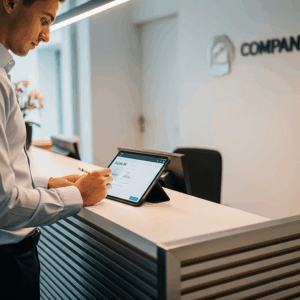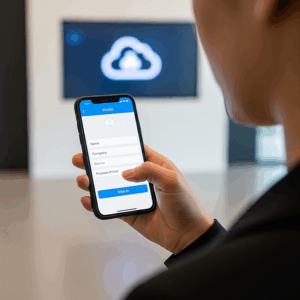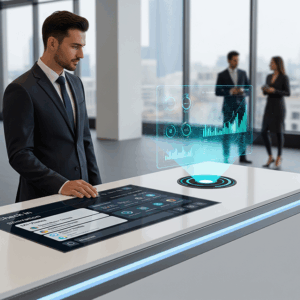
News & Updates

The Visitor Management Evolution: From Sign-In Sheets to Biometrics
Digital visitor management has swiftly evolved from basic sign-in sheets to advanced, biometric-enabled platforms. In 2025, organisations across public, healthcare, and corporate sectors require solutions that secure premises, streamline workflows, and enhance visitor experiences. Modern systems like ATT InfoSoft’s Visitor Management System (VMS) showcase how technology now delivers robust security, compliance, and efficiency. This article explores the key milestones in visitor management, revealing why biometrics and integrated analytics have become the new standard for operational excellence and trust.
The Paper Era: Manual Sign-In and Its Limitations
For decades, visitor management relied on handwritten logs and manual tracking at the reception desk. While such systems were straightforward, their simplicity came at the cost of efficiency and security. As organisations expanded and regulatory requirements grew more complex, the drawbacks of paper-based sign-in sheets became increasingly evident. Manual processes were slow to execute, prone to errors, and offered little in terms of operational insight or audit capability. Staff spent valuable time reconciling visitor entries, and the absence of digital records made it challenging to enforce security policies or satisfy compliance audits. In environments with high footfall, such as hospitals or government offices, queues would often form at entry points, further impeding service delivery and diminishing the visitor experience.
The limitations of paper-based visitor management extended far beyond inconvenience. The inability to track visitors in real time, safeguard sensitive information, or produce timely reports left organisations exposed to risks and regulatory scrutiny. As digital transformation gathered pace across sectors, it became clear that manual sign-in systems were no longer fit for purpose driving the need for more reliable, accountable, and future-ready solutions.
Operational Inefficiency and Human Error
Manual sign-in sheets were frequently mismanaged, resulting in lost or incomplete records. Staff were tasked with reconciling visitor logs by hand, a process that consumed significant time and heightened the risk of mistakes. High-traffic environments, such as healthcare institutions and government offices, often experienced queues at reception desks, which slowed entry and disrupted service delivery. These inefficiencies not only frustrated visitors but also diverted staff from more critical duties, undermining overall productivity.
The absence of automation meant that simple errors such as illegible handwriting or missed entries could go undetected, compromising the accuracy of visitor records. Over time, these operational gaps eroded trust in the system and highlighted the need for digitalisation.
Security Risks and Compliance Challenges
Paper logs offered limited security. Unauthorised access and the possibility of tampering or lost records posed real threats, especially in sectors like healthcare and finance where accountability is essential. Manual systems struggled to meet growing regulatory standards, making it difficult to track visitor movements or provide reliable audit trails.
As compliance requirements increased, organisations quickly realised that manual sign-in processes lacked the visibility and control needed for modern security and regulatory environments. This highlighted the need for digital solutions that ensure both security and proper record-keeping.
Digitisation: The Arrival of Electronic Visitor Management
The move from paper logs to electronic visitor management was a turning point for efficiency and security. Digital platforms replaced manual processes with automated registration, secure data storage, and real-time tracking. Self-service kiosks and tablets made check-in quicker and more accurate, while instant reporting improved compliance and audit readiness.
Automation reduced manual errors, sped up entry, and integrated with security systems like access control and CCTV. This shift strengthened site security, supported regulatory compliance, and delivered a better visitor experience with faster check-ins and shorter queues.
Automated Registration and Reporting
Electronic visitor management enabled quick self-check-in at kiosks or tablets, reducing staff involvement and improving record accuracy. Instant reporting supported audits and compliance, while automation minimised errors and incomplete logs.
Features like automated notifications and badge printing streamlined workflows, allowing staff to focus on more important tasks rather than manual paperwork.
Integration with Security Protocols
Digital visitor management platforms offered seamless integration with access control systems, CCTV monitoring, and badge printing solutions. This synergy facilitated real-time monitoring of visitor movements throughout the facility, improving site security and enabling more effective incident response. In environments such as healthcare and government offices, these integrations were essential for meeting regulatory compliance and safeguarding sensitive areas.
The ability to tie visitor registration to physical access controls meant that only authorised individuals could enter restricted spaces, reducing the risk of unauthorised access and reinforcing operational integrity.
Improved User Experience
Electronic systems delivered a noticeably improved visitor experience. Faster check-in processes and automated notifications minimised queue times, while touchless registration options and multilingual interfaces catered to a broader range of user needs. Visitors appreciated the convenience and speed of digital platforms, which reduced frustration and made entry more efficient. Staff, too, benefited from reduced administrative burdens and fewer manual interventions.
For organisations aiming to enhance customer satisfaction and operational productivity, the adoption of electronic visitor management systems represented a significant step forward. Digitalisation not only addressed legacy issues but also set the stage for further innovation.
Cloud-Enabled Platforms and Mobile Integration
The evolution of visitor management continued with the rise of cloud-enabled platforms and mobile integration, enabling organisations to scale operations and enhance flexibility. Cloud-based visitor management systems allowed for centralised data storage and remote access, supporting organisations with multiple locations and complex workflows. Facility managers could now monitor entry points and visitor activity from anywhere, improving oversight and resource planning.
Mobile integration introduced new possibilities for pre-registration and contactless entry. Visitors could use mobile apps or web portals to register before arrival, receive QR codes or digital passes, and check in seamlessly upon arrival. These advancements not only reduced bottlenecks at reception but also increased transparency and responsiveness, further elevating the visitor experience.
Centralised Data and Remote Management
Cloud-based visitor management systems enabled organisations to centralise visitor data, making records accessible across multiple sites and departments. Facility managers gained the ability to monitor and control entry points remotely, supporting more efficient oversight and resource allocation. This centralisation was particularly valuable for organisations operating in regulated sectors, where comprehensive reporting and data integrity are essential for compliance.
Remote management also facilitated rapid response to incidents or changes in visitor patterns, allowing organisations to adjust protocols and staffing as needed to maintain security and service quality.
Mobile Access and Pre-Registration
Mobile integration empowered visitors to pre-register using dedicated apps or web portals, streamlining the arrival process and reducing wait times. Upon registration, visitors received QR codes or digital passes, which enabled contactless check-in and real- time notifications for hosts. These capabilities improved both security and convenience, ensuring that only authorised individuals could access facilities and that hosts were promptly informed of arrivals.
The combination of mobile access and cloud-based data management supported a more agile, responsive visitor management system one that could adapt to changing operational requirements and user expectations in real time.
Data Analytics: Enhancing Security and Operational Insights
Advanced visitor management solutions began leveraging data analytics to drive smarter operations and strengthen security. These platforms collect and analyse visitor data in real time, enabling organisations to identify patterns, optimise resource allocation, and improve compliance. Integrated dashboards provided live visibility into site occupancy and visitor flows, while automated alerts notified security teams of irregular activity or unauthorised access attempts.
Historical analytics allowed organisations to track peak traffic periods, recurring visitors, and service bottlenecks, supporting evidence-based decision making. Facility managers could use these insights to adjust staffing, refine workflows, and maintain regulatory compliance, fostering a culture of continuous improvement. The ability to generate detailed reports further enhanced accountability and audit readiness, especially in high-accountability environments such as healthcare and finance.
Real-Time Monitoring and Alerts
Integrated dashboards gave organisations live visibility into visitor flows, site occupancy, and entry point activity. Automated alerts were triggered by irregular behaviour, such as unauthorised access attempts or prolonged stays, allowing security teams to respond swiftly and effectively. Real-time monitoring reduced the risk of security breaches and ensured that any anomalies were addressed promptly, maintaining the integrity of the facility.
These features enabled proactive risk management and supported compliance with safety protocols, reinforcing organisational resilience in dynamic environments.
Evidence-Based Decision Making
Historical analytics provided organisations with actionable insights into visitor behaviour and operational trends. By analysing data such as peak traffic periods, frequent visitors, and workflow bottlenecks, facility managers could make informed decisions about staffing, resource allocation, and process improvements. These data-driven strategies supported continuous optimisation and helped organisations maintain high standards of service delivery and compliance.
The use of analytics also facilitated more accurate reporting for audits and regulatory reviews, ensuring that organisations could demonstrate accountability and transparency to stakeholders.
Biometrics and AI: The New Standard in Visitor Authentication
In 2025, biometrics and artificial intelligence have become the defining features of next-generation visitor management systems. Platforms such as ATT InfoSoft’s VMS integrate facial recognition, fingerprint scanning, and advanced AI algorithms to deliver unmatched security, efficiency, and user convenience. Biometric verification ensures precise identification, reducing the risk of impersonation and unauthorised entry. For sectors with strict regulatory requirements like healthcare and finance these capabilities support robust compliance and safeguard sensitive assets.
AI-powered threat detection takes security a step further, analysing visitor behaviour and flagging anomalies such as repeated access attempts or suspicious patterns. This proactive approach empowers organisations to pre-empt risks and uphold safety in high-accountability environments. Modern VMS platforms also prioritise privacy and data protection, incorporating encrypted storage and GDPR-compliant practices to ensure that sensitive information remains secure and accessible only to authorised personnel. Audit trails provide clear evidence of accountability, building trust with visitors and supporting organisational integrity.
Biometric Verification for Secure Access
Biometric technologies such as facial recognition and fingerprint scanning have transformed visitor authentication. These modalities enable precise, rapid identification, reducing the likelihood of impersonation and unauthorised entry. In environments where compliance and security are paramount, biometric verification supports adherence to regulatory standards and strengthens overall site protection.
Organisations benefit from greater control over access points and improved traceability, making it easier to enforce policies and respond to incidents effectively.
AI-Powered Threat Detection
Machine learning algorithms analyse visitor behaviour in real time, flagging anomalies such as repeated access attempts, unusual movement patterns, or unauthorised activities. These capabilities empower security teams to pre-empt risks, investigate incidents, and uphold safety in high-accountability environments. AI-driven threat detection enhances situational awareness and supports rapid decision making, minimising the impact of potential security breaches.
By combining biometric authentication with AI analytics, organisations achieve a new level of operational resilience and regulatory compliance.
Privacy and Data Protection
Modern visitor management platforms prioritise privacy and data protection through encrypted data storage and GDPR- compliant policies. Sensitive visitor information is accessible only to authorised personnel, with robust audit trails ensuring accountability and transparency. These measures build trust with visitors, reassure stakeholders, and support organisational integrity in sectors where data privacy is a critical concern.
Audit-ready systems facilitate compliance with evolving regulations, enabling organisations to demonstrate responsible data stewardship and operational excellence.
Future-Ready Visitor Management for Smarter Operations
Digital visitor management has evolved into a cornerstone of secure, efficient, and customer-focused operations. By integrating biometric authentication and AI-driven analytics, organisations can meet stringent compliance requirements, protect assets, and deliver seamless visitor experiences. ATT InfoSoft’s VMS exemplifies this transformation, empowering clients across diverse sectors to advance digital transformation, build trust, and achieve operational excellence. As the landscape continues to evolve, investing in future-ready visitor management systems ensures that organisations remain agile, resilient, and prepared for the challenges ahead.
Contact ATT at infosoft-sales@attsystemsgroup.com for details.
Send us a message
Contact Information
Address:
35 Ubi Crescent, ATT Building, Singapore, 408585
Phone:
Email:
Website:
www.attsystemsgroup.com







